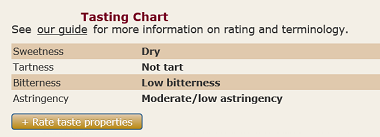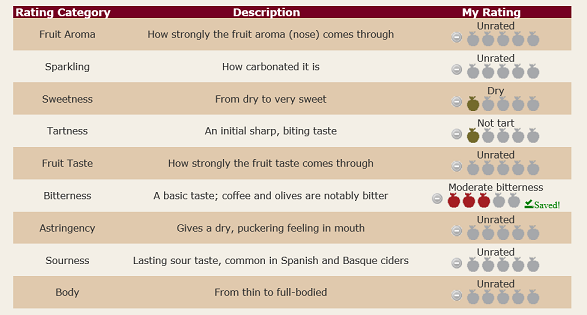Understanding taste properties
CiderExpert gives ratings for some of most notable, easier to recognize taste properties of cider, including:
- Sparkling: Ciders range from completely still to champagne-like bubbles.
- Fruit Aroma: How much of a nose/aroma of fruit is present?
- Sweetness: How dry or sweet does this taste? Some cideries rate the sweetness of their ciders, but your opinion may differ.
- Fruit Taste: How strongly does the cider taste like fruit?
- Body: How thin or full is the mouthfeel of the cider?
CiderExpert also has ratings for some more difficult to recognize, but still important, taste properties:
- Tartness: Comes primarily from the malic acid in the apples; responsible for the "sharp" taste.
- Bitterness: One of the five basic tastes. Common examples include coffee, unsweetened cocoa and olives. In ciders this can come from tannins or other bittering agents.
- Astringency: An astringent cider can give a puckering feeling in your mouth, and leave a dry feeling after swallowing. This same feeling can come from overly-steeped tea. Astringency in ciders is typically from tannins.
- Sourness: Like the "sour" in sour beers. Common in Spanish and Basque ciders, and some fruit ciders, but less common otherwise.
- Turbidity: How cloudy or hazy does the cider look? This is often due to the amount of filtration.
- Funky: Yes, this is a term. It's not as specific as some taste properties, and includes earthy and yeasty aftertastes, and generally tastes evoking a "farmyard".
- Acidity: This is the total acidity of the cider. Tartness and sourness come from specific acids, while this accounts for any acid content.
The ratings for each taste property is determined by CiderExpert users (see below), and shown like:

Evaluating taste properties
When you see the current display of taste properties for a cider (see above), click on the button labeled "Rate Taste Properties," and you'll see a table like this show up.

These ratings aren't good or bad, they are meant to capture how intense each aspect of the cider's flavor is. A rating of '1 apple' for sweetness means it's dry, not that you don't like its amount of sweetness. Likewise, a very sweet cider should get a '5 apple' rating for sweetness, even if you hate sweet ciders.
When you select the rating, a description appears, translating your rating to words. Your rating is saved automatically (you'll see a Saved! message appear, as above by Bitterness).
The ratings from all users are combined to give an overall rating for each taste property that others can use in deciding what to drink.
How much to rate
If you are a casual cider drinker and want to start developing your palate, you can set "Normal" rating mode by clicking on the button when you see this on the rating chart for a cider:

Then you will be asked to evaluate the five typically easiest to recognize taste properties:
- Sparkling
- Fruit Aroma
- Sweetness
- Fruit Taste
- Body
If you are an expert cider drinker, you'll be able to show that off by setting "Expert" rating mode and rating all of the properties.

Write a review
Whether you are a cider novice or expert, you can submit a written review to guide others when considering this cider. Click on the button to write a review, and you'll get some space to type. Click Save, and you're done!

